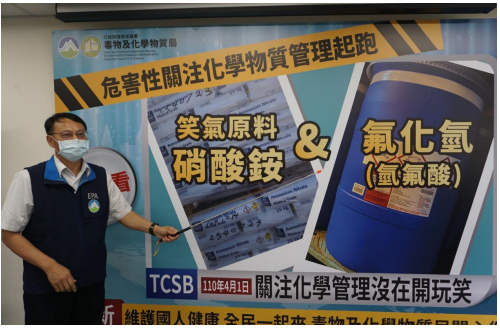- Department:Chemicals Administration Ministry of Environment
The EPA preannounced in early April 2021 that ammonium nitrate and hydrofluoric acid have been added to the list of concerned chemical substances. Relevant controls concerning handling were announced based on the substances' characteristics and uses in the nation. In addition to listing them as concerned chemical substances with harmful effects, the preannouncement also signals the start to strengthened controls over potential risk areas where accidents may occur, such as the import, manufacture, use, storage, transportation, and sale of these substances.
The EPA pointed out that with different agencies responsible for managing ammonium nitrate and hydrofluoric acid, tracking of the flow of these substances and accident prevention and response is not well-regulated. After listing the two substances for control, the EPA will track them properly and gather complete data on their importation, transportation after they enter the country, storage, manufacture, use and management by enterprises. The aim is to have all departments working together, with individual delegated responsibilities, to manage the two substances.
Ammonium nitrate is often used in the production of agricultural fertilizers, dynamite, and explosives for mining. But improper storage and management can lead to accidents, such as the large blast in the port of Beirut, Lebanon in August 2020. Ammonium nitrate is also a raw material for nitrous oxide (laughing gas), the first concerned chemical substance announced and listed for control. Highly pure laughing gas can be generated after ammonium nitrate goes through thermal decomposition, so proper management of ammonium nitrate simultaneously constitutes proper management of a main precursor substance for laughing gas production.
Hydrofluoric acid can be made by adding water to hydrogen fluoride. Due to its corrosive properties, it is widely used in the etching and washing of semiconductor chips and other industrial uses. The solution is also commonly called "bonemelting water" or "white bone acid," which erodes and irritates the skin. Dermatological reactions such as pain, whitening, and reddish swelling occur when 11 highly concentrated hydrofluoric acid contacts skin, while more severe effects include blistering and sloughing from skin. In Taiwan, besides injuries caused by improper use, there have been multiple incidents where highly concentrated hydrofluoric acid was intentionally used in attacks. Once hydrofluoric acid is listed for control, besides the factories that use it, chemical raw material retailers and other channels that sell hydrofluoric acid shall be required to obtain approval documents to handle it in their operations, and thus risks will be reduced.

Director. General Yen-Ju Hsieh of Toxic and Chemical Substances Bureau explained the Control of Harmful Concerned Chemical Substances
Source: EPA Major Environmental Policies, May 2021



